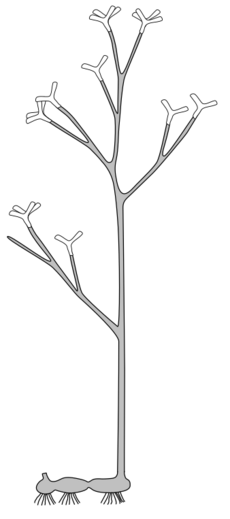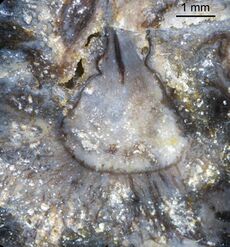Biology:Horneophyton
| Horneophyton | |
|---|---|

| |
| Schematic reconstruction of Horneophyton lignieri to show its growth habit | |

| |
| Fossil corm (tuber) in Rhynie chert | |
| Scientific classification | |
| Kingdom: | Plantae |
| Class: | †Horneophytopsida |
| Order: | †Horneophytales |
| Family: | †Horneophytaceae Kenrick & Crane (1997)[2] |
| Genus: | †Horneophyton Bargh. & Darrah (1938)[1] |
| Species: | †H. lignieri
|
| Binomial name | |
| †Horneophyton lignieri (Kidston & Lang 1920) Barghoorn & Darrah 1938
| |
| Synonyms | |
|
Genus
Species
| |
Horneophyton is an extinct early plant which may form a "missing link" between the hornworts and the Rhyniopsida. It is a member of the class Horneophytopsida. Horneophyton is among the most abundant fossil organisms found in the Rhynie chert, a Devonian Lagerstätte in Aberdeenshire, UK. A single species, Horneophyton lignieri, is known. Its probable female gametophyte is the form taxon Langiophyton mackiei.
Description
The sporophyte had bare stems (axes) up to 20 cm high and about 2 mm in diameter with an undivided cortex. Stomata were present but rare. There was a thin central strand of conducting tissue, but this was not reinforced with spiral and reticulate thickenings and thus does not constitute true vascular tissue.[2] Early stages of development of the sporophytes of Horneophyton (as of hornworts) may have been dependent on their parent gametophytes for nutrition, but mature specimens have expanded, corm-like bases to their stems, up to 6 mm in diameter, that bore rhizoids and appear to be anchored in soil, suggesting a capacity for independent existence after the gametophyte had degenerated.
The sporangium (spore-forming organ) is unique among both living and fossil plants, consisting as it does of branched lobes at the apex of some of the branches of the stem. Each lobe contains a central collumella, analogous to the sporangia of hornworts; however, the sporangia of hornworts are not branched.[3][4] The number of lobes possessed by a sporangium varied; at least three orders of dichotomous branching have been found, resulting in more than four lobes. The sporangia were much less regular than shown in most reconstructions (including that opposite), and they had 'bumps' or emergences on them. Spores were released through a slit at the top of each lobe.[5] The sporangia of Horneophyton contained trilete meiospores, the surfaces of which were decorated with short conical protuberances.[3][6]
The female gametophyte of the plant has been recognised and described as the form taxon Langiophyton mackiei.[7] It grew to a height of around 6 cm, and was free-living. The species was dioicous (unisexual), since it produced male and female gametes on separate gametophytes.[8]
Horneophyton grew on sandy, organic-rich soil in damp to wet locations. They usually grew as isolated individuals.[9]

Taxonomy
First named by Kidston & Lang in 1920 from Early Devonian fossils in the Rhynie chert,[10] the original generic name Hornea was later found to occupied by a flowering plant in the family Sapindaceae, Hornea mauritiana, leading Barghoorn and Darrah to propose renaming the genus to Horneophyton in 1938.[1] It was classified as a rhyniophyte (subdivision Rhyniophytina) by Banks, but the absence of true vascular tissue led Kenrick and Crane in 1997 to create a new class, Horneophytopsida, for this and similar genera.[11] A single species, Horneophyton lignieri, has been described.[2]
Phylogeny
A possible phylogeny for Horneophyton is shown below (based on Crane et al. for the polysporangiophytes[12] and Qiu et al. for the bryophytes.[13]
|
liverworts | |||||||||||||||||||||||||||||||||||||
| |||||||||||||||||||||||||||||||||||||
With vascular tissue but bryophyte-like vascular tissue and sporangia, the organism has been considered a missing link between the hornworts and the vascular plants or tracheophytes (which molecular data suggest are sister groups).[13] Features suggesting a relationship with the hornworts include the general form of its sporangia; its corm also resembles the foot of some hornworts. The free living nature of its sporophytes, and the fact that they branching repeatedly, are marked differences which force it into the stem group of tracheophytes (along with Aglaophyton).
References
- ↑ 1.0 1.1 Barghoorn, E.S.; Darrah, W.C. (1938), "Horneophyton a necessary change of name for Hornea", Harvard University Botanical Museum Leaflets 6 (7): 142–4, doi:10.5962/p.168398
- ↑ 2.0 2.1 2.2 Kenrick, Paul; Crane, Peter R. (1997), The Origin and Early Diversification of Land Plants: A Cladistic Study, Washington, D.C.: Smithsonian Institution Press, ISBN 978-1-56098-730-7
- ↑ 3.0 3.1 Eggert, D.A. (1974), "The sporangium of Horneophyton lignieri (Rhyniophytina)", American Journal of Botany 61 (4): 405–13, doi:10.2307/2441808
- ↑ Taylor, T.N.; Taylor, E.L.; Krings, M. (2009), Paleobotany, The Biology and Evolution of Fossil Plants (2nd ed.), Amsterdam; Boston: Academic Press, ISBN 978-0-12-373972-8, pp. 237–8
- ↑ El-Saadawy, W.E.-S.; Lacey, W.S. (1979), "The sporangia of Horneophyton lignieri (Kidston and Lang) Barghoorn and Darrah", Review of Palaeobotany and Palynology 28 (2): 137–144, doi:10.1016/0034-6667(79)90005-8
- ↑ Wellman, C.H.; Kerp, H.; Hass, H. (2004), "Spores of the Rhynie chert plant Horneophyton lignieri (Kidston & Lang) Barghoorn & Darrah, 1938", Transactions of the Royal Society of Edinburgh: Earth Sciences 94 (4): 429–43, doi:10.1017/s0263593303000300
- ↑ Remy, W.; Hass, H. (1991), "Langiophyton mackiei nov. gen., nov. spec., ein Gametophyt mit Archegoniophoren aus dem Chert von Rhynie (Unterdevon Schottland)" (in German), Argumenta Palaeobotanica 8: 69–117
- ↑ Taylor, Taylor & Krings 2009, p. 234
- ↑ Selden, P.A.; Nudds, J.R. (2006), Fenster zur Evolution : Berühmte Fossilfundstellen der Welt, München: Elsevier Spektrum Akademischer Verlag, ISBN 978-3-8274-1771-8
- ↑ Kidston, R.; Lang, W.H. (1920), "On Old Red Sandstone plants showing structure, from the Rhynie chert bed, Aberdeenshire. Part II. Additional notes on Rhynia gwynne-vaughani Kidston and Lang; with descriptions of Rhynia major, n.sp., and Hornia lignieri, n.g., n.sp", Transactions of the Royal Society of Edinburgh 52 (24): 603–27, doi:10.1017/s0080456800004488, https://zenodo.org/record/1428662
- ↑ Edwards, Dianne (2003), "Embryophytic sporophytes in the Rhynie and Windyfield cherts", Transactions of the Royal Society of Edinburgh: Earth Sciences 94 (4): 397–410, doi:10.1017/S0263593300000778, http://orca.cf.ac.uk/10510/1/Edwards%202003.pdf, p. 399
- ↑ Crane, P.R.; Herendeen, P.; Friis, E.M. (2004), "Fossils and plant phylogeny", American Journal of Botany 91 (10): 1683–99, doi:10.3732/ajb.91.10.1683, PMID 21652317
- ↑ 13.0 13.1 Qiu, Y.L.; Li, L.; Wang, B.; Chen, Z.; Knoop, V.; Groth-Malonek, M.; Dombrovska, O.; Lee, J. et al. (2006), "The deepest divergences in land plants inferred from phylogenomic evidence", Proceedings of the National Academy of Sciences 103 (42): 15511–6, doi:10.1073/pnas.0603335103, PMID 17030812, Bibcode: 2006PNAS..10315511Q
External links
- Horneophyton at the University of Aberdeen. Includes images. (The apparent size of the corms in the reconstruction is inconsistent with the cross-sections shown earlier. See Weiss, H.-J., Chert News: Other errors and mistakes in palaeontology literature, archived from the original on 2011-03-18, https://www.webcitation.org/5xH6LzGrm?url=http://www.chertnews.de/errors.html.)
- Cladogram from Crane, Herendeen & Friis 2004
Wikidata ☰ Q148549 entry
 |

